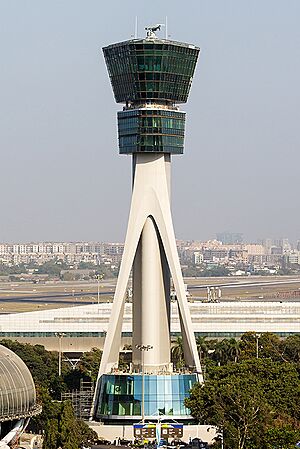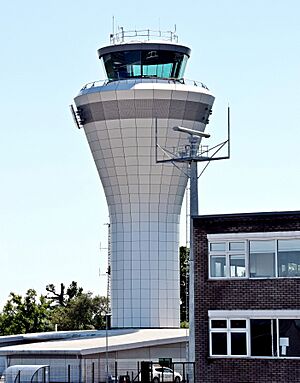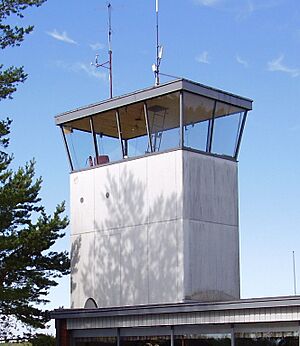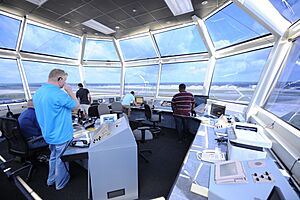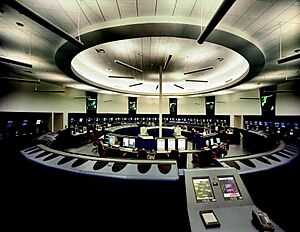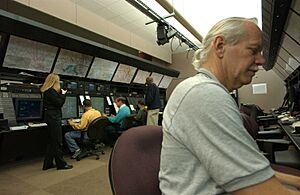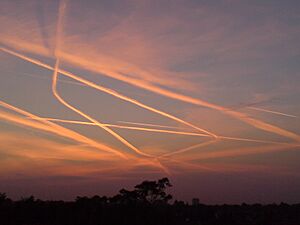Air traffic control facts for kids
Air traffic control (ATC) is a special service that helps airplanes fly safely. It's done by people called air traffic controllers who work on the ground. They guide planes on the ground and through certain parts of the sky, called airspace. Their main goals are to stop planes from crashing, keep air traffic moving smoothly, and give pilots important information.
Air traffic controllers watch where planes are using radar. They talk to pilots using radio. To prevent crashes, they make sure each plane has enough empty space around it. This is called traffic separation. ATC helps all kinds of planes, including private, military, and commercial aircraft. Controllers give pilots instructions that must be followed. Sometimes, they give advisories or flight information, which pilots can choose to follow or not. However, the pilot in charge of a plane always has the final say for safety, especially in an emergency.
Contents
- Language Used in Air Traffic Control
- A Brief History of Air Traffic Control
- Airport Traffic Control Tower
- Approach and Terminal Control
- Area Control Centre / En-route Centre
- Challenges in Air Traffic Control
- Call Signs for Aircraft
- Technology in Air Traffic Control
- Air Navigation Service Providers (ANSPs)
- Future Changes in Air Traffic Control
- ATC Regulations in the United States
- See also
Language Used in Air Traffic Control
The International Civil Aviation Organization (ICAO) sets rules for air traffic control. Because of these rules, ATC operations use either English or the local language of the ground station. Usually, the local language is used, but controllers must switch to English if a pilot asks.
A Brief History of Air Traffic Control
In 1920, Croydon Airport near London, England, was the first airport to have air traffic control. Their first "aerodrome control tower" was a wooden hut about 15 feet high. It started on February 25, 1920. This tower gave pilots basic information about traffic, weather, and their location.
In the United States, air traffic control grew in different ways. After World War I, in 1922, the U.S. Post Office started using methods from the U.S. Army to guide air mail planes. These early stations later became flight service stations. Today, these stations give pilots information but don't control flights directly. They can relay instructions from ATC in areas without direct radio coverage.
The first airport control tower in the U.S. opened in Cleveland in 1930. It managed planes arriving, departing, and moving on the ground. In the 1950s, after radar was used, new facilities were created to control busy airspace around big airports. The first center to guide planes between airports, called an air route traffic control center (ARTCC), opened in Newark in 1935. Others followed in Chicago and Cleveland in 1936.
After a terrible mid-air crash in the 1956 Grand Canyon mid-air collision that killed 128 people, the FAA (Federal Aviation Administration) took over air traffic control in the United States in 1958. Other countries also improved their systems. In 1960, several European countries formed Eurocontrol to manage their airspace together. The Maastricht Upper Area Control Centre (MUAC), started in 1972, is an example of countries working together to control airspace. In 2001, the European Union (EU) aimed to create a "Single European Sky" to make air travel more efficient.
In the USSR, the first air traffic control service began in 1929 for the route between Moscow and Irkutsk. By 1930, control areas were set up along all existing air routes.
Airport Traffic Control Tower
The main way to control planes right around an airport is by watching them from the airport control tower. This tower is usually a tall building with many windows, located on the airport grounds. The air traffic controllers in the tower are responsible for keeping planes and vehicles separate on the airport's taxiways and runways. They also manage planes in the air near the airport, usually within 5 to 10 nautical miles. Controllers must follow strict rules but also need to be flexible for different situations, often under pressure.
A Remote and virtual tower (RVT) system allows air traffic controllers to guide planes from a different location, not directly at the airport tower.
Ground Control
Ground control, sometimes called ground movement control (GMC), is in charge of the areas where planes move on the airport ground. At some very busy airports, they use special radar called surface movement radar (SMR).
Air Control or Local Control
Air control, known to pilots as "tower" or "tower control," is responsible for the active runways where planes take off and land.
Flight Data and Clearance Delivery
Clearance delivery is the part of ATC that gives pilots their flight route instructions. These instructions are usually given before a plane starts moving on the ground. They include details about the path the plane will fly after it takes off.
Approach and Terminal Control
In the U.S., these facilities are called TRACONs (Terminal Radar Approach Control). They are given a special three-digit code, like C90 for the Chicago TRACON. These centers manage planes as they get close to or leave busy airports.
Area Control Centre / En-route Centre
These centers control aircraft that are flying between airports, often at higher altitudes. They make sure planes stay safely separated during long flights.
Radar Coverage
Some air navigation service providers use a newer technology called automatic dependent surveillance – broadcast (ADS-B). Instead of radar finding a plane, an ADS-B equipped plane "broadcasts" its own position. This position is figured out by the plane's own navigation equipment. ADS-C is another type of automatic surveillance where the plane reports its position at set times. Controllers can ask for more frequent reports, but this costs money for the airline. ADS-C is very useful in areas where radar systems can't be built, like over oceans.
A radar archive system (RAS) saves all radar information for several weeks. This can be helpful for search and rescue missions. If a plane disappears from radar, controllers can look at the last radar signals to guess its location.
Challenges in Air Traffic Control
Traffic Management
Air traffic control errors happen when planes get too close to each other. This means the safe distance (either up-and-down or side-to-side) between them becomes too small. These errors often occur after very busy times when controllers might relax and miss something important.
Weather Impacts
Weather greatly affects flying around the world. More than 70% of air traffic delays are caused by bad weather. This leads to many delays, planes being sent on different routes by ATC, and cancellations across continents. For example, in 2024, Europe saw a 40% increase in weather-related delays for planes already in the air compared to 2023. As bad weather becomes more common and severe, organizations like the Civil Air Navigation Services Organisation (CANSO) are asking for better teamwork and real-time solutions to deal with these problems.
Infrastructure Needs
The global ATC system is very complex and different in various regions. Many countries face issues with old technology, not enough staff, and more planes flying. While some areas, like parts of Europe and the U.S., have started modernizing their systems (like SESAR and NextGen), many others, especially in developing countries, still use older radar and voice communication. This makes things less efficient and safe. These differences cause delays and make the overall air traffic management less strong. The ICAO says that coordinating ATC systems and using more digital technology is key for future aviation needs. A 2024 report from the International Air Transport Association (IATA) also stressed the need to invest in flexible, data-driven systems to handle growth after the pandemic and keep the network working well.
Congestion Issues
When there are too many planes and not enough control capacity, it leads to flight cancellation and delays. In America, delays caused by ATC increased by 69% between 2012 and 2017. A big reason for this congestion was not having enough ATC staff. More efficient ATC could save 5-10% of aviation fuel by avoiding planes having to wait in holding patterns or fly longer, indirect routes.
In some countries, like China, the military uses a large part of the airspace. This leaves only narrow paths for airliners, causing congestion. The United Kingdom only closes its military airspace during military exercises.
Call Signs for Aircraft
To keep planes safely separated, each flight uses a special call sign. These are given out by ICAO, usually for regular flights and some military flights. There are written call signs, like AAL872 or VLG1011, which appear on flight plans and radar screens. There are also audio or radio-telephony call signs, which are what pilots and controllers say on the radio. These are not always the same as the written ones. For example, "Speedbird 832" might be used instead of "BAW832." This helps avoid confusion.
For other flights, the call sign is usually the plane's registration number, like "N12345" or "C-GABC." On the radio, pilots might use the last three letters of the registration number, using the NATO phonetic alphabet (like "alpha-bravo-charlie" for C-GABC). In the United States, the type of aircraft might be used, like "Cessna 842" for "N11842."
Technology in Air Traffic Control
The Federal Aviation Administration (FAA) has spent a lot of money on software to make ATC systems more automated. In 2002, the United Kingdom opened a new control center at London Area Control Centre (LACC) in Swanwick. This new center took over from a busy one near London Heathrow Airport. The software used there is mainly from Lockheed-Martin. At first, the center had problems with its software and communications, causing delays and occasional shutdowns.
Here are some tools that help controllers:
- Flight data processing systems: These systems handle all the information about a flight, from when it leaves the gate to when it arrives. They also help with other tools, like finding possible conflicts between planes.
- Short-term conflict alert (STCA): This system checks for possible crashes in the next two or three minutes.
- Center TRACON automation system (CTAS): This is a set of tools developed by NASA to help controllers make decisions. Some of these tools help manage traffic, space planes for landing, and plan arrivals.
- MTCD and URET: In Europe, there are several tools like iFACTS and VAFORIT that help detect conflicts. The Single European Sky ATM Research (SESAR) program is working on new technologies for future air traffic needs.
- Nav Canada's EXCDS system: This is another system used in Canada.
- Screen content recording: This feature in modern systems records what controllers see on their screens. These recordings are used with audio recordings to investigate incidents and analyze events later.
- Communication navigation surveillance / air traffic management (CNS / ATM) systems: These systems use digital and satellite technologies to create a smooth global air traffic management system.
These are the organizations that provide air traffic control services. They can be different in each country.
- Spain – AENA (Spanish Airports) and ENAIRE (ATC & ATSP)
- Vietnam – Vietnam Air Traffic Management Corporation (VATM)
- Zambia – Zambia Civil Aviation Authority (ZCAA)
- Zimbabwe – Zimbabwe Civil Aviation Authority
Future Changes in Air Traffic Control
In the United States, new ways to control traffic are being looked at:
- Free flight: This is a new idea where planes would manage their own paths more directly. Instead of a central controller, parts of the sky would be reserved automatically using computers to keep planes safely separated.
In Europe, the Single European Sky ATM Research (SESAR) program is developing new methods and technologies for future air traffic needs. In October 2018, European controller unions felt that setting targets to improve ATC was "a waste of time." They worried that new technology might cut costs but also threaten their jobs. In April 2019, the EU called for a "Digital European Sky." This would focus on saving money by having common digital standards. It would also allow controllers to move where they are needed, instead of merging national ATC systems. Even large, unified ATC systems in America and China still face congestion. Eurocontrol tries to reduce delays by sending flights on less busy routes. For example, flight paths across Europe were changed to handle the new airport in Istanbul. However, the extra capacity will likely be used up by the increasing demand for air travel.
Well-paying ATC jobs in Western Europe might move to Eastern Europe where labor is cheaper. For example, Spanish controllers earned a lot more than the average salary in 2010. French controllers also went on strike for many months between 2004 and 2016.
Privatization of ATC
Many countries have changed their air navigation service providers from government-run to private companies. There are different ways this can be done. One way is for ATC services to be part of a government agency, like in the United States. The problem with this is that funding can be unstable, which can slow down new technology and training. Both supporters and opponents of privatization agree that stable funding is very important for upgrading ATC systems.
Supporters argue that moving ATC services to a private company could make funding more stable. This would lead to more predictable planning and faster rollout of new technology and training. As of November 2024, the United States has 265 contract towers. These are staffed by private companies but managed by the FAA through its Contract Tower Program, which started in 1982. These contract towers handle 51% of all federal air traffic control towers in the U.S.
Another way is for ATC services to be run by a government-owned company. Germany uses this model, and funding comes from fees paid by users. A third model is a for-profit company running ATC services, like in the United Kingdom. However, this system has had problems, including a big failure in December 2014 that caused delays and cancellations. This failure was linked to cost-cutting measures by the company. In fact, earlier that year, the German government-owned company won a bid to provide ATC services for Gatwick Airport in the United Kingdom.
The last model, often suggested for the United States, is a non-profit organization handling ATC services, like in Canada. The Canadian system, Nav Canada, is often seen as a successful example of privatization. Nav Canada is a private non-profit organization that has lowered costs and allowed new technologies to be used faster. This has led to shorter flights, less fuel use, and safer flights. Nav Canada gets its money from fees collected from airlines based on the plane's weight and the distance flown.
Most air traffic control is run by national governments. In the European Union, only Italy has private shareholders. Privatization doesn't always mean lower prices. For example, MUAC had a very high profit margin in 2017 because there is no competition. However, governments could offer fixed-term concessions to encourage better service.
ATC Regulations in the United States
The airspace in the United States is divided into 21 large zones, called centers. Each zone is then divided into smaller sections. Within each zone, there are also areas about 50 miles across called TRACON (Terminal Radar Approach Control) airspaces. Inside each TRACON airspace are several airports, each with its own airspace about 5 miles in radius. FAA control tower operators (CTO) and air traffic controllers follow the rules in FAA Order 7110.65 for all air traffic procedures.
See also
 In Spanish: Control del tráfico aéreo para niños
In Spanish: Control del tráfico aéreo para niños
- Air traffic service
- Flight information service officer
- Flight planning
- ICAO recommendations on use of the International System of Units
- Forward air control
- Global air-traffic management
- List of tallest air traffic control towers in the United States
- RMCDE
- Tower en route control (TEC)


